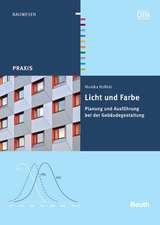Introduction to Eurocode 2: Design of concrete structures
Autor A. Alexandrou, D Beckett Nfaen Limba Engleză Paperback – 16 oct 1997
This book guides the reader through the background to the Eurocodes and explains the main differences between them and the equivalent Standard Codes of Practice. An Introduction to Eurocode 2 will be invaluable for engineers who need to learn about the new code and how it can be used effectively in design.
Preț: 790.34 lei
Preț vechi: 963.83 lei
-18% Nou
Puncte Express: 1186
Preț estimativ în valută:
151.23€ • 158.32$ • 125.13£
151.23€ • 158.32$ • 125.13£
Carte tipărită la comandă
Livrare economică 05-19 aprilie
Preluare comenzi: 021 569.72.76
Specificații
ISBN-13: 9780419201403
ISBN-10: 0419201408
Pagini: 208
Dimensiuni: 210 x 297 x 13 mm
Greutate: 0.68 kg
Ediția:1
Editura: CRC Press
Colecția CRC Press
ISBN-10: 0419201408
Pagini: 208
Dimensiuni: 210 x 297 x 13 mm
Greutate: 0.68 kg
Ediția:1
Editura: CRC Press
Colecția CRC Press
Public țintă
Postgraduate and UndergraduateCuprins
Preface. Notation. Introduction. Design for durability. Load arrangements and analysis. Section analysis 1: Slabs and beams. Section analysis 2: Beam-column joints. Section analysis 3: Columns and walls. Earthquake engineering. Design example. Appendices: Tables of reinforcement areas; Guidelines for preliminary design; Ratio of design bending moments (EC2/BS8110); Yield line analysis - design formulae; The strip method with numerical application; Column design charts; Beam design charts; Typical details for a frame designed for seismic actions. Index.
Notă biografică
Derrick Beckett is a Visiting Fellow at the University College of Greenwich and teaches structural design at University College London. Andrew Alexandrou was formerly Principal Lecturer in the School of Land & Construction Management, University of Greenwich.
Descriere
An introduction to the European Code of Practice for Design of Concrete Structures, EC2. It guides you through the background to the Eurocodes and explains the main differences between them and the equivalent Standard Codes of Practice. It is suitable for engineers who need to learn about the new code and how it can be used effectively in design.











